XIX. BROWN TABBY PERSIANS
Texte und Bilder aus “THE BOOK OF THE CAT” von Frances Simpson aus dem Jahre 1903
THE BOOK OF THE CAT
CHAPTER XIX.
BROWN TABBY PERSIANS
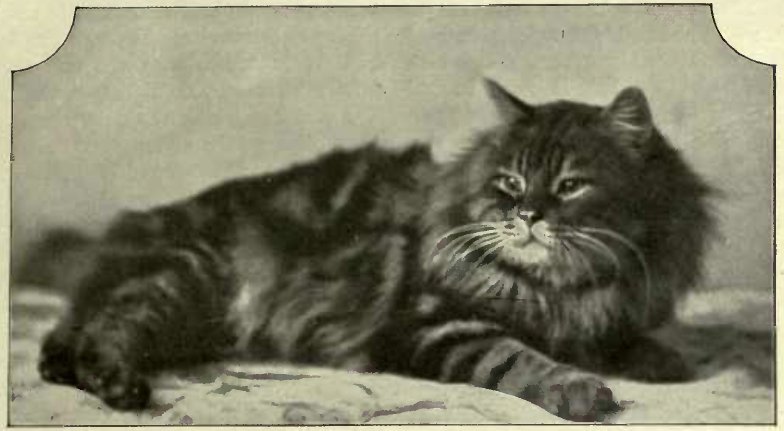
MY first prize-winning kitten was a brown tabby, exhibited many years ago at the Crystal Palace. He became my stud cat “ Rajah,“ called after an Indian prince who was visiting us at that time. “ Rajah “ was wholly and devotedly attached to the lady of his choice, namely, my blue Persian “ Mater.“ These two names occur in the pedigree of many a prize-winner of the present day, and very numerous were the lovely litters I reared from this eminently respectable pair of Persians. I never knew either “ Rajah “ or „Mater“ troubled with a day’s illness, and if one of their kittens had died such an event would have caused as much astonishment as grief. But I must return to my tabbies.
I cannot explain it, but certain it is that of all the feline race (blues not excepted) the warmest corner in my heart has always been kept for the brown tabbies. There is something so comfortable and homely about these dear brownies—they seem to have more intelligent and expressive countenances than any other cats, and I am firmly of opinion
that no Persian cats are so healthy and strong as brown tabbies. They are a hardy race, and as such I have frequently recommended novices in the fancy to start with a good brown queen, and with ordinary care they may reasonably expect to rear litter after litter without the difficulties and disasters that one hears of in connect on with the bringing up of Persian kittens in general.
I know there is a kind of idea that brown tabbies are a common sort of cat, and this breed is often spoken of in a most disparaging way. Then, again, the ignorant in the cat world have an extraordinary notion that tabbies are always females ! Perhaps because we sometimes hear a meddlesome or gossiping woman called a „tabby“—and I had a dear old friend who always bade me beware of “ tabby bipeds “ among catty communities !
The word „tabby“ is supposed to have had its origin in a certain street in Bagdad called „Atab,“ which was chiefly inhabited by weavers of a particular kind of material called “ Atabi.“ This is what Harrison Weir says on the subject :—“ The word ‚ tabby ‚ was derived from a kind of taffeta, or ribbed silk, which
tabbies—the splashed or heavily marked, and the barred or ticked. I think the former the handsomer breed, with the well denned and
when calendered, or what is now termed evenly balanced side markings, the dark spine
‚ watered,‘ is by that process covered with line (not too wide), the clear rings round the
wavy lines. This stuff in bygone times was chest (commonly called the “ Lord Mayor’s
often called ‚ tabby,‘ hence the cat with lines chain „), the paws ringed in graduated bars to
or markings on its fur was called a tabby cat. the foot. On the head and face the markings
Certain it is that the word ‚ tabby ‚ only should be very clear and distinct, the narrow
referred to the marking or stripes, not to the dark head lines running symmetrically till
absolute colour, for in ‚Wit and Drollery ‚is the following :—
Her petticoat of satin, Her gown of crimson tabby.
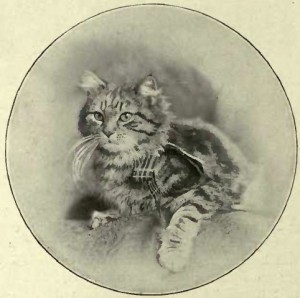
Be that as it may, I think there is little doubt that the foregoing was the origin of the term. Yet it was also called the brindled cat, or the \ tiger cat, and with V some the grey cat— ‚ graymalkin.“ We are told also by the same authority that tabby cats in Norfolk and Suffolk were called cyprus cats, they join the broad spine-line. The ruff should be of the light shade, and ears of the same tone lend great distinction to this cat. As in the other tabby breeds, the browns are terribly addicted to white chins ; in fact, I think it is certainly rarer to find a brown tabby without this blemish than an orange, more pains having been taken to eradicate the evil in orange tabbies. There is no denying the fact that brown tabbies are a very neglected
cyprus being a reddish-yellow colour, so that breed, and at present the only one, except
the term may have applied to orange as well tortoiseshell – and – white, that is not taken
as brown tabbies. The term “ tiger cat “ is, I up by a specialist society. This is a crying
believe, often used in America, and it well shame, and it remains for some ardent admirer
describes the true type of a brown tabby. The of the dear brown tabbies to form a club,
groundwork should be of a bright tawny shade, and to try to breed really good specimens of
with a dash of burnt sienna, the markings a the golden-brown order; not the drab or grey
dark seal brown—almost black. As regards animals that are so frequently seen at our
the colour of eyes in brown tabbies, I prefer shows, and which are very far removed from
the golden or orange; but some of the finest the genuine article.
cats in this variety have possessed the green I do not think that any breed can produce
eye, and some fanciers are disposed to prefer such fascinating kittens. They have such re-
this colour, which I think should be the markably intelligent expressions, and, as a rule,
speciality of the silvers. Anyhow, a good the sturdy cobby shape and broad heads of
brilliant green is preferable to a washed-out brown tabbies are very conspicuous. This breed
undecided yellow.
should distinctly be massive in build, with
There are two distinct types of brown plenty of bone and muscle ; in fact, with brown tabbies the larger the better, if well whether near or distant, this beautiful breed proportioned. With the sterner sex brown will gain all the admiration and attention that tabbies are decided favourites, and I cannot help it deserves. There is a distinct kind of brown noticing that the very few fanciers who have tabby, so called, which may better be de-taken up this breed amongst the gentler sex scribed as sable. These cats have not the are what might be termed strong-minded. regular tabby markings, but the two colours I have also remarked that when once are blended one with another, the lighter sable fanciers start breeding brown tabbies they tone predominating. At the Crystal Palace continue, and this cannot be truly said of other breeds—silvers, for instance ; but I would fain see a steady increase to the ranks of breeders of brown tabby Persians, and more encouragement given at shows. I know that as matters now stand fanciers complain they cannot get any market for their tabby kittens, and that classification is poor at shows and prizes scarce. It is all too true, but surely it is a “ long lane that has no turning,“ and as every dog has its day, so perhaps in the future, Cat Show of 1902 the class was for brown tabby or sable. I was judging, and, considering the mixed entries, I felt that markings must not be of the first importance, and so awarded first and second to Miss Whitney’s beautiful sable females, the third going to a well-marked though out of condition brown tabby. These sable-marked cats are rare, but still more beautiful would be a cat entirely of the one tawny colour—a self sable, without markings. “ The most suitable factors to obtain this colour,“ so writes Mrs. Balding, “ would probably be tortoiseshell – and – sable tabby, as free from marking and as red in ground colour as possible. A cross of orange, bright coloured and as nearly as obtainable from unmarked ancestors, would be useful. Some nine years ago I purchased a dimly marked bright sable coloured cat, ‚ Molly,‘ shown by Mrs. Davies at the Crystal Palace, with a view to producing a self-coloured sable cat; but ‚ Molly‘ unfortunately died, and I abandoned the idea.“ The nearest approach to a self-sable I have ever come across was a cat I obtained for the Viscountess Esher, which had, alas ! been neutered. He was almost unmarked, and of the colour of Canadian sable, with golden eyes —a most uncommon specimen.
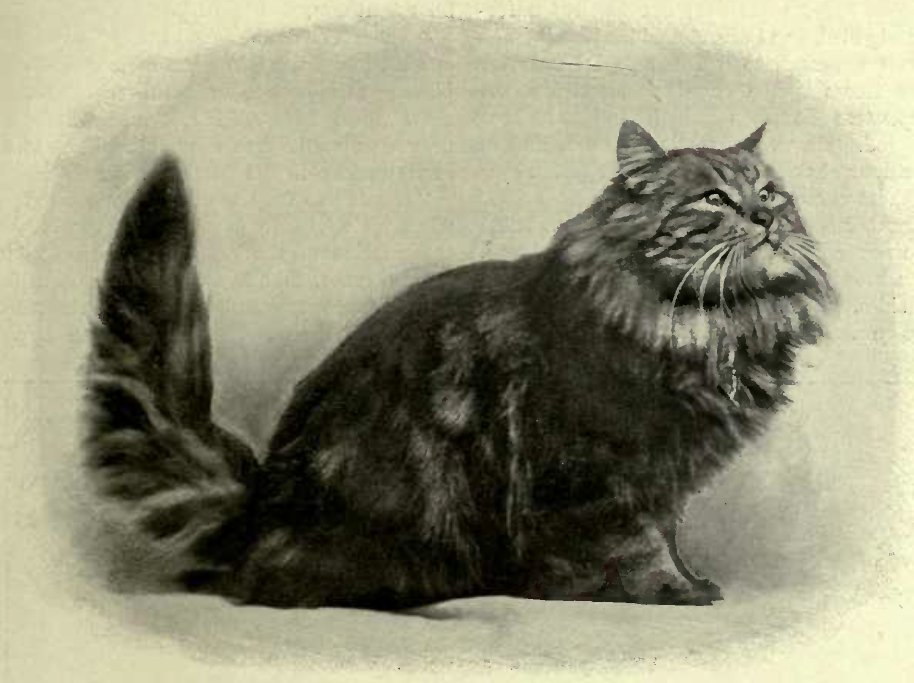
Another species is the spotted tabby, but I
have never seen a true specimen in Persians.
Some brown tabbies are ticked or spotted on
the sides, but they have the spine line and
ings on neck, head, and tail.
Very few and far between have been good brown tabbies in the history of the fancy. Amongst the males two names may be said to stand out conspicuously—Miss Southam’s “ Birkdale Ruffie “ and my own “ Persimmon.“ Both these cats, of quite different types, have gone to their rest.
As regards the famous Birkdale strain, the following account, kindly supplied to me by Miss Southam, will be of interest :—
“ There is no doubt that, until quite recently, .our old friend the tabby has been deliberately placed in the background, and regarded in the show world with an indifference which has proved an unmistakable stumbling block to the improvement of this particular breed.
“ Nor is this very much to be wondered at, when we take into consideration the hideous combination of the drab, colourless browns, dowdy greys, and indistinct markings which had hitherto constituted the chief charms of the typical tabby. Instead, it would appear that the commonplace and unattractive grey was openly encouraged, rather than otherwise ; for, although the silver tabby was provided with a classification of his own, only one class was relegated to “ brown and grey tabbies,“ either colour being considered equally worthy of carrying off premier honours !

“ It was at this period, when the nondescript tabby was reigning supreme, that Champion ‚ Birkdale Ruffie ‚ made his debut in the show world, my sister, Miss Emily Southam, being the first to bring the sable tabby into prominence. \Yhether, however, it was that the public was not sufficiently up-to-date to appreciate the sudden departure from the usual sombre colours with which it had hitherto been satisfied to a brilliant sable, or whether he was particularly unfortunate in his choice of judges, it is difficult to say ; at any rate, it was not until four years after his first appearance in the show pen that he met with the justice that his many beautiful points so richly deserved. In fact, after exhibiting him at several shows, where he was deliberately passed over for other and most inferior cats, he being in the pink of condition, my sister was so annoyed at the treatment he received that she simply burnt the schedules which poured in upon her and kept him at home, determined he should not be further insulted by such flagrant injustice !
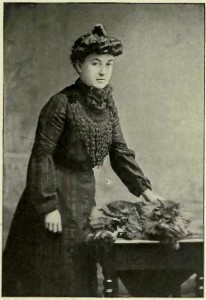
“ It was at the \Yest of England Cat Show in 1894 that ‚ Birkdale Ruffie ‚ scored his first real success—I believe under Mr. Gresham— winning two first prizes in the open and novice classes and two specials. Here at last his beautiful sable colouring, his dense black markings, and wonderfully expressive face were appreciated.
“ The year 1896 was the occasion of his sensational win at the Crystal Palace show. He simply swept the board, carrying everything before him—first prize, championship, several specials, and the special given by the King (then Prince of Wales)—for the best rough-coated cat in the show, the prize being a handsomely framed portrait of the King with his autograph attached. Mrs. Vallance was judge. Again, in 1897, he was shown with great success at the Crystal Palace, winning first prize, championship, and special.
“ This was the occasion of ‚ Birkdale Ruffie’s‘ last appearance before the public, as it was during the following month my sister was taken dangerously ill, and for this reason his pen at the Brighton show was empty. After her death we determined to subject him no more to the trials and discomforts of the show pen, so ‚ Ruffie,‘ who was now seven years old and a great pet, both for his own sake and that of his mistress, only too gladly retired into the privacy of home life, spending the cold winters by the fireside in his own little snug retreat, and in the long summer days lying under his bower of shady hops, lazily watching his facsimile, his little son ‚ Master Ruffie,‘ growing up more beautiful each day and ready to take up the thread of his father’s famous career in the exhibition world.
“ Into the latter ‚ Master Ruffie ‚ made his debut without any of the numerous anxieties encountered by his celebrated parent. The way was paved for him, and when he appeared at the Crystal Palace show in 1899, in all the full glory of his youth and beauty, it was difficult for the judges to realise that it was not their old favourite who was now confronting them through the wires !
“ ‚ Master Ruffie ‚ has only been shown on two occasions—in 1897 as a kitten, and in 1899 at the Crystal Palace, when he returned home with his box literally filled with cards, his winnings including three first prizes, four specials, and a championship.
“ I am sorry we can manage to get no really good photo of ‚ Master Ruffie.‘ Time after time we have attempted it—in studios, out of doors, by means of professionals and amateurs —including many kind relatives and friends with their ever-ready little Kodaks! ‚ Master Ruffie ‚ steadfastly refuses to face the camera. Again and again the button is pressed in vain, and only the glimpse of a vanishing tail upon the negative is all we have to show as ‚ Ruffle’s ‚ portrait !
“ But we have only to look at ‚ Birk-dale Ruffle’s‘ picture, and we have ‚ Master Ruffie‘ too ! The only difference between them is that the.latter is a very cobby little fellow, being perhaps shorter in the
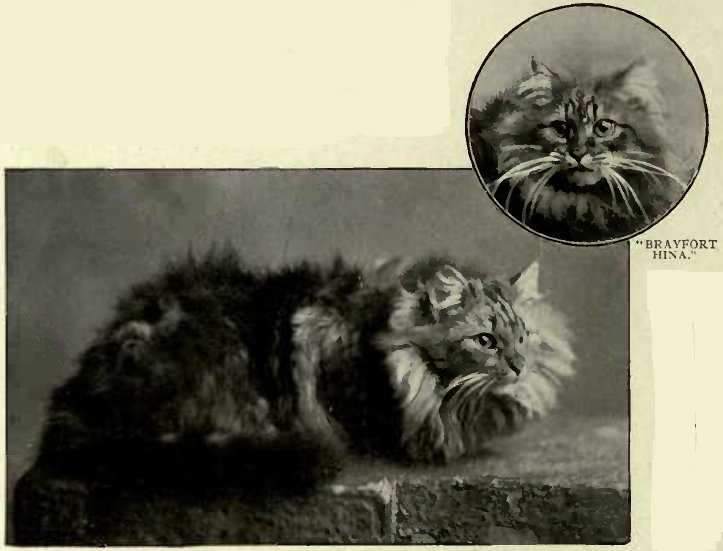
legs, which makes him appear to be a somewhat smaller cat than his father. In fact, at the Crystal Palace show he was pronounced by the judges to be perfect in every point.
“ ‚ Birkdale Ruffie ‚ was noted for the extreme beauty of his expression ; he had certainly one of the most characteristic faces ever seen in a cat, and his son inherits the same. The former was constantly the subject of sketches in the illustrated papers, those by Mr. Louis Wain being especially lifelike.
“ Some of ‚ Master Ruffle’s ‚ descendants are, I believe, in the possession of Miss Witney, and have met with great success in the show pen.
“ Our cattery is built on the principle of shepherds‘ huts, each house having a separate wire run, with shrubs planted, and a thick wall of ivy in the background, which gives a picturesque appearance to the whole of the little colony. In summer a mass of luxuriant hops makes a welcome shade from the hot sun.
“ The houses are warmed by gas stoves, on which the cats love to sit, purring contentedly,
and with the pretty curtained windows, carpets, wickerwork armchairs, and cosily cushioned benches, I think ‚ Master Ruffie‘ and his seven feline playmates have a pretty easy time in this tempestuous world !
‚ The one bone of contention is that the cats have appropriated the sunniest corner of the garden, their houses having the much desired southern aspect, which our gardener looks at with longing eyes for his beloved peaches and early peas. Happily, he bears the little occupants no grudge, and when we go from home takes over the whole of the cattery into his charge.“
Here let me give a few details of my dear from the country to London obliged me to
departed puss. „Persimmon“ was a well- board him out.
known character in the fancy, and had the „Persimmon“ sired some splendid kittens,
distinction of being a champion in the National which whenever shown proved themselves
Cat Club and the Cat Club. It was in 1899 worthy of their sire’s long prize – winning
when, judging at Brighton, I was greatly taken record. At the Crystal Palace show of 1902 with a wonderful-headed brown tabby that came under my awards. I gave him first in his class, and when later I obtained a catalogue and saw his price was a very reasonable one, I purchased him, and I may say I never made a better bargain, in or out of the cat fancy. “ Persimmon “ (as I afterwards called him, in memory of the Derby winner) was bred by Mr. Heslop, of Darlington, that astute and clever cat fancier ; and his grandsire was “ Brown Prince,“ a noted Northern prize-winning tabby. I have never seen such a wonderful head as that which made “ Persimmon’s “ chief glory.
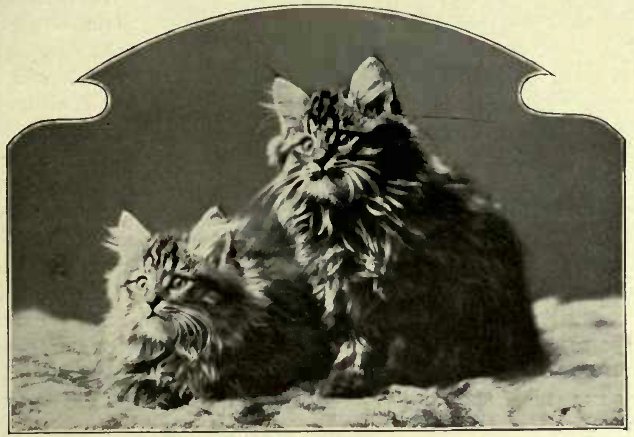
His face was very round, and his nose quite a snub, and he was blessed with tiny ears and short tail. His shape was perfect, but the markings on his back were rather too heavy, and alas ! he had a white under-lip. But, taking him all round, he was a grand specimen, and a most lovable puss. He fretted himself to death when a change of residence
Miss Whitney exhibited two of his progeny
— a superb neuter „Persimmon Laddie,“
who covered himself with glory and his
cage with cards, and a beautiful kitten
that had previously won at Manchester and
has since been purchased at a high figure by
a lover of the brownies. At the Specialist
Show at Bath in January, 1903, “ Persimmon
Laddie“ was again to the fore, and won in
the open and ring classes. “ Persimmon “ was
a great loss, for good brown tabbies are
rare. I hope, however, to purchase a fine,
well-grown son of my dear old “ Simmy,“ and
as „Persimmon II.“ I trust it may be a case
of „like father like son,“ and that by-and-
by we may find quite a long list of brown
tabby Persians “ at stud “ in the columns of
the catty papers.
I think I may with truth assert that brown tabbies arc more appreciated, ‚and that better specimens are produced in the North than in the South of England. I have mentioned Mr. Heslop as having owned some splendid specimens, and at one time he used to exhibit quite a number at our Southern shows. Miss Eggett, of Manchester, has a grand tabby of the golden order named “ Cleopatra.“ Mrs. Whittaker has some nice specimens, and Mrs. Mackenzie’s „Cleo“ was much admired at the Westminster show in 1900, when she took first in her class. Mrs. Ricketts has always been partial to the breed, and Mrs. Stead’s “ Timber“ has done some winning. Miss Gray’s “ Lady Babbie “ was one of the finest brown queens that used to visit “ Persimmon,“ and another was Miss Meeson’s “ Jolie,“ whom I used greatly to admire. Miss Derby Hyde exhibits a wonderful copper-coloured brown tabby called “ Maraquetta,“ who, if only possessed of a good head and shorter face, would be a splendid specimen. Mrs. Davies formerly owned “ Susan,“ a cat now in the possession of Mrs. G. Wilson, very good in colour and markings, but failing in head and face. Mr. Western, of Sandy, has a good male in “ Wynstay Monarch.“ In the West of England Mrs. Hellings and Mrs. Gregory are admirers and breeders of brown tabbies.
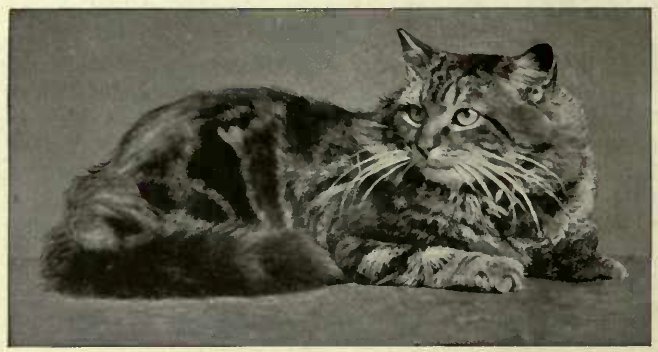
Mrs. Gregory, of Bath, started breeding brown tabbies in 1899. Her female (a black) she mated to her stud cat “ Azor,“ and, curiously enough, all the litters have consisted of brown tabbies, the kittens numbering
sixteen in all. When, however, “ Queen Caterpillar “ was mated to Mrs. Gregory’s blue Persian, her kittens were all black.
A picture of two pretty brown tabby kittens bred by Mrs. Gregory appears in this chapter. I am happy to say that Mrs. Gregory intends to continue breeding brown tabbies, and has kept a handsome specimen from one of her recent litters to perpetuate the strain. Mrs. Drury, of Graffham, is very faithful to the brownies, and in her lovely old-fashioned cottage near Petworth she is always surrounded by several of her pet pussies. She writes as follows :—
“ When first I received a margarine basket, and out of it came a little brown fluffy kitten, I knew no more about Persian cats than the man in the moon—in fact, he probably knew more, as he is frequently the only witness to their nocturnal gambols. I had heard of such things as Persian cats, yet never remember having seen one. However, kind friends soon gave me a helping hand, and as time went on and my fluffy kitten became a fluffy cat, being passionately fond of animals, I soon found out the very fascinating ways of dear ‚ Miss Wiggs,‘ so named because the fur on her head in her kitten days would stand erect, and it is the only name she condescended to answer to. She has been—and is so still, in spite of all her maternal cares and five years‘ experience— one of the healthiest pussies imaginable, and has never had one day’s illness since she came into my possession, though I believe, in her babyhood, distemper nearly carried her off; and all her children have been equally healthy— in fact, I have never lost one of her kittens, which is, I imagine, almost a unique experience.
“ ‚ Miss Wiggs‘ came from a blue father and a silver mother, but has, with one exception, always had brown babies, even when mated to a silver. The varied beauties of blues, silvers, whites, and blacks have never taken such a hold upon me as compared with the fascination of the browns, and it is quite a wonder to me more fanciers do not breed them. Nothing looks handsomer, to my mind, than a rich brown, tabby male with tawny markings, like a young lion, and judging from my experience they amply repay any trouble taken by their loving ways and robust health. I have a son of ‚ Miss Wiggs ‚ and poor old ‚ Persimmon ‚ now, who follows me like a little dog, even out in the road, and goes for a walk running by my side.
“ Perhaps what would astonish a stranger most on coming to see me is the way my catty family lives in peace and contentment with the dogs, and very often I find two or three kittens in the dogs‘ basket very busily occupied cleaning my little bull-terrier. It is a point of honour amongst the happy family that they never touch each other’s food, and very rarely is this broken, and not infrequently we see three, and perhaps four, cats sitting round the dog while he eats his dinner, waiting for any leavings, and the same with the dog. Persians have the reputation of being bad mousers. ‚ Miss Wiggs ‚ makes quite the exception, and on one occasion caught and killed two mice at the same time ; one she held in her paws and the other in her mouth. Young rats also she has many times brought in, to show what a useful little person she is, and her children follow in her footsteps.
“ In a great measure I attribute my brownies‘ good health to the open-air life they lead. From early morning to when darkness approaches they have the run of a large garden, even on a wet day. They go in and out of the houses as they like ; never sleep indoors, always in a very dry little outside cattery — in summer on benches, and in winter in nice boxes with straw.
“ Perhaps, financially, blues or silvers may be greater successes, but brownies have been my first love and will always remain so. I am only sorry I cannot show what a lovely head and sweet face dear ‚ Miss Wiggs ‚ has, but she absolutely declines to be photographed.
“ In time I hope more fanciers may realise how rich in colour and markings a good brown tabby is, and then we may hope to see this beautiful breed brought more to the fore at all the leading shows.
“ As ‚ Mis? Wiggs ‚ has been the foundress of my cattery, perhaps a short description of her would not be amiss. She is a ticked tabby— that is to say, she has not the broad, dark stripes with tawny splashes ; her ground colour is a beautiful golden brown, and down the back and sides are pencilled stripes, more like the markings on a silver. Round her face, nose, and ears she has most lovely golden brown shades; eyes are green—they used to be amber; her head is very broad and well shaped; and her expression is very sweet.
„When mated to a silver, as she has been twice, the litters have been equally divided— two silvers and two brownies ; but both silvers and browns in that case had broad dark and light markings, in no way resembling the ticking of the mother. But when mated to poor old ‚ Persimmon ‚ the kittens have been equally divided, always two resembling the maternal side exactly, and two following out ‚ Persimmon’s ‚ beautiful splashes. When mated to a brown tabby all the kittens were brown. She has never thrown a black ; but her daughter, whose father was ‚ Abdul Zaphir,‘ and who I also mated to ‚ Persimmon,‘ had two blacks and two very dark tabbies in her litter. ‚ Wiggs ‚ has in all her five litters had only two females. Her average is four or five . kittens ; she looks after them entirely herself, and has never been the worse for so doing ; but I do not allow her more than one family a year, and until the kittens can lap she is fed every two hours.“
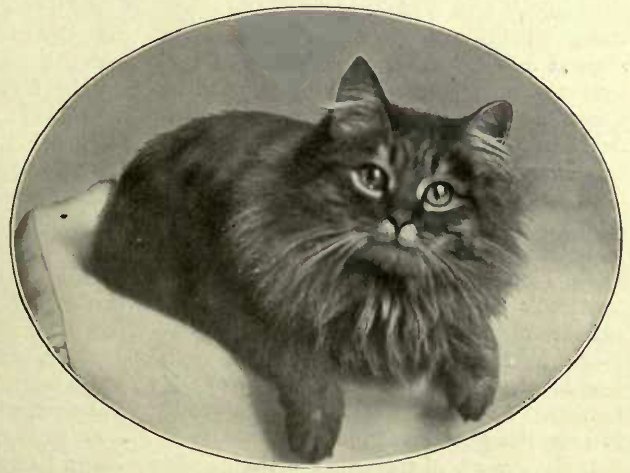
The best-marked brown tabby I have ever seen was Lady Marcus Beresford’s‘ “ Bas-sorah,“ who was unfortunately given away and lost. Her markings looked like oil painting, they stood out in such distinct relief-Another specimen of a different type was imported by Lady Marcus Beresford, namely “ Kismet.“ She was of the ticked order, with small pencilled markings, very compact and cobby in shape. Mrs. Herring has always possessed good brown tabbies. To begin with, “ Adolphe,“ who used formerly to win everything till his son, “ Prince Tawny Boy,“ stepped into his shoes, to be displaced later by his own son, “ Prince Adolphe,“ and his exquisite daughter, “ Floriana,“ now in America. Another good son of “ Adolphe’s “ was Mrs. Bonar’s “ Lord Salisbury.“ To go back as far as I can recollect, there was Mr. Horrel’s “ Nero,“ and Mrs. Pearce’s “ Juliet “ and “ Rosebud,“ also Miss Malony’s “ Lind-fields Lion“ and the Hon. Mrs. McLaren Morrison’s “ Cetewayo “ and “ Mazawattee,“ this latter a really wonderful cat which was imported by Mrs. Davies at the same time as the celebrated “ Nizam,“ and reported to be his brother. Anyway, he resembled him greatly in everything but colour.
For sables we, of course, go to the Birkdale strain. I remember the incomparable “ Birkdale Ruffie “ in his full glory at the Crystal
Palace—a mass of red-brown fur, of the style of „Persimmon Laddie,“ but with more distinct markings and a very keen, almost fierce, expression ; in fact, he looked like a wild animal !
Then “ Master Ruffie “ appeared as a kitten, and later as a mild edition of his sire. From this celebrated strain Miss Whitney’s lovely sables are descended. This enthusiastic fancier has kindly written some notes on her favourite breed. Her cats are all pets, and lead a life of luxury in their town and country houses on the other side of the Irish Channel. Miss Whitney says :—
“ I am pleased to see that brown tabbies are coming to the front again, after being such a long time in the background. It now rests with fanciers of this charming variety of the feline species to improve them in all points. We hear often that they should be a rich tan in ground colour, clear and dense in markings, profuse in coat, ruff and frill, large round head, small ears, and no white lip. I should consider this a perfect specimen ; but where is such to be had ? I do not say it will not be obtained, but up to this I have never seen it. Now what we are to endeavour is to breed up to this high standard. This will take time, no doubt ; but, above all, do not let us give up everything for markings, though they are very essential.
“ My idea of a brown tabby is that it must be of a rich tawny ground colour. How could a brown tabby be called a brown if it is only a greyish drab ? I should prefer to do without such perfect markings, but to have the more desirable rich colour, and, above all, plenty of coat, ruff, and frill; if it has not these latter qualities, it could not be called a Persian, which must have an abundance of fine soft-textured coat. If we only breed for marking, why not mate to a ‚ short-hair,‘ which is more likely to be perfect in that point ? But then, where would be our true Persian ? Now, as to white lip, I have never seen a good brown tabby without it, but I hear that there are such, though they fail in colour. I would prefer the well-coated cat with good colour and markings and a white lip to one that failed in these other points and had no white lip (I do not mean when it extends to a white throat). Now if we happen to breed a good kitten without a white lip, and should strive to mate her to a really well-marked stud cat, even should he fail in colour—perhaps we might get even one kitten nearly reaching perfection as the result. It would reward the patience, expense, and time ; but we need never expect a profusely coated cat to show as distinct markings as an in-feriorly coated one will. I breed nothing but brown tabbies, but cannot say I have yet obtained perfection. I have,
I feel sure I shall remain faithful to them to the end of my career as a cat fancier. At present I have not a cat of any other colour . in my cattery.
“ I still have ‚ Ruffle,‘ who is now a very large neuter, splendidly marked, but perhaps not quite up to the standard in other points for the English show bench. ‚ Bray-fort Fina‘ is, I may say, a sable tabby, being particularly rich in colour all throughout— indeed, more often of an auburn 4an than brown. She is very profuse in coat, carrying a long body-coat and a big ruff and frill. She is a very large cat, with plenty of bone, and well made, with a fine-shaped head.
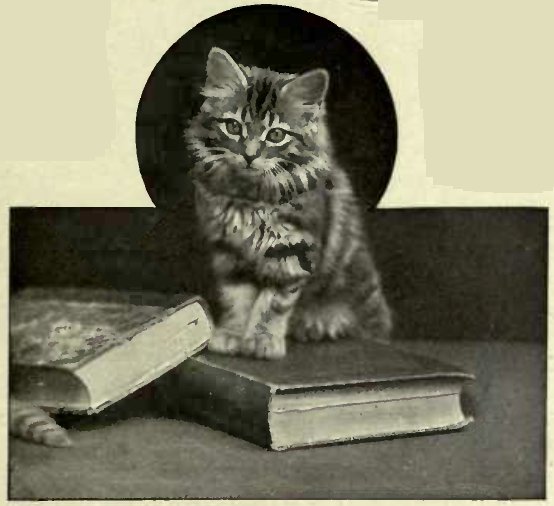
however, secured coat and colour, and expect to attain the other desirable points in the near future, as we must all persevere, but always let us breed up to the standard of the true Persian.
“ I first became interested in cats by being given a nice brown tabby Persian kitten, which I called ‚ Ruffle,‘ and got very fond of him ; but as he seemed lonely I thought of getting another kitten as a companion for him, so I then purchased a pretty little silver tabby from Miss Cochran ; but after some time, of all the varieties I saw, none pleased me so well as the brown tabbies. This breed I have gone in for altogether during the past few years, and 15
She was once mistaken for a male by a well-known judge. ‚ Fina‘ was bred by Miss G. Southam, and is by ‚ Master Ruffie‘ ex ‚ Bluette,‘ her sire being a son of the famous ‚ Champion Birkdale Ruffle.‘
“ She was already a winner when I purchased her, and has since won many times, including second and special at Bristol, 1899, in a mixed sex class, being beaten by a male. At Belfast, in 1900—the following year—she was beaten out of first by her sister, ‚ Brayfort Princess.‘ She then took second at Westminster, 1902 ; first at Reading, and first and championship at the Crystal Palace, 1901 and 1902. Again first at the Bath Specialist
Show in the same year, where her gorgeous late ‚ Champion Persimmon ‚ ex ‚ Fina.‘ He colouring was called in question and an un- _ won first and special at the kitten show in supported protest was made that she was dyed ! October, 1902, and first and two specials at
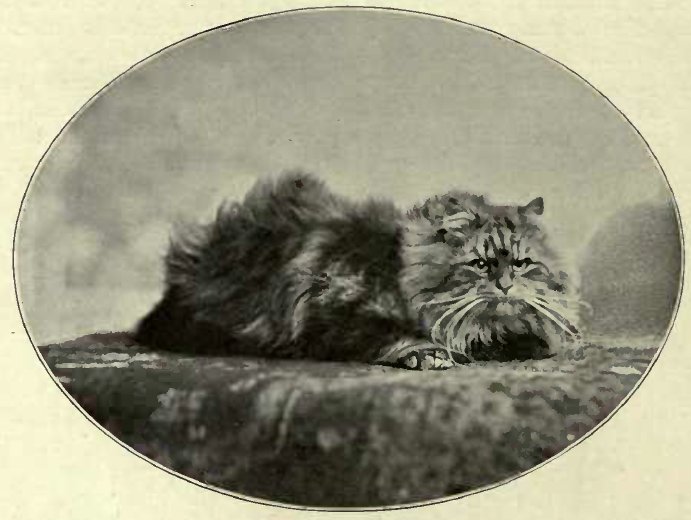
She is a most successful breeding cat, her produce being usually winners. Her sister, ‚ Brayfort Princess,‘ is also a sable tabby, and carries an immense coat, ruff, and frill ; it is denser than ‚ Fina’s,‘ and I.fancy but for the latter ‚ Princess ‚ would have been more heard of as a winner, as, except on one or two occasions, she has been usually beaten by ‚Fina.‘ “ ‚ Brayfort Persimmon Laddie ‚ is by ‚ Champion Persimmon‘ ex ‚ Brayfort Fina.‘ He made his public appearance at Bristol when he was four months old, taking first and special in a tabby kitten class and third in novice, against an entry of twenty-five adults ; then he won first and special in kittens, and second in open to his mother’s first at Belfast in 1900; also he took first and special for best long-haired neuter at Manchester in 1901 ; first, Liverpool; and first and two specials at the Crystal Palace, 1902. He is too well known to comment on. He is a wonderful sable colour, and is superb in coat. ‚ Brayfort Sable Boy‘ is also by the
the Crystal Palace show, 1902 ; his wins speak to his merit.
“ I find all my cats very strong and healthy, and even in the coldest winter they never have artificial heat. I attribute having never lost a pet after a show to taking them away at night. Unless something very unforeseen occurred, nothing would induce me to leave a cat of mine in a show.
I have found mating to a good brown tabby much the most successful. I tried mating to an orange, but did not like the results. I always mated to the late ‚ Champion Persimmon,‘ and had never fewer than six kittens in a litter—sometimes eight—all strong and healthy. Twice only have I lost any, and on these occasions the fault lay with the foster mothers.
“ In the spring and summer my cats get a run out in the garden every day; the two neuters go on leads, but the females have their liberty ; indeed, unless I were present ‚ Fina‘ would not leave the house. Their rooms look out on the grass terrace, so they can come in or out as they please till their breakfast time, which is at about ten o’clock. They are groomed every morning between 8 and 8.30 o’clock, winter and summer, and always fed regularly. Their sleeping houses, as in photo, are about four feet long, lined round with oilcloth, so they can be washed when necessary. In the winter the bedding is hay, and in summer, shavings. The houses are sufficiently long to allow for sanitary boxes during the breeding time. I find Hall’s washable distemper very nice for the cattery walls, and it looks so bright and fresh. The floor-covering is linoleum.“
In America brown tabbies are beginning to find favour, and several good specimens have been exported. “ Arlington Hercules,“ who took first at Westminster in 1901, was shipped to Mrs. Sarmiento and Mrs. Cutler, and I sent a „Persimmon“ kitten out by Mrs. Robert Locke to Mrs. Clinton Locke, the president of the Beresford Club. He was passed on to her honorary secretary, and in Field and Fancy of December, 1902, the following notice appears :—
“ Miss Lucy Johnstone is the fortunate owner of ‚ Persimmon Squirrel,‘ a son of the noted brown tabby ‚ Persimmon,‘ who lately died. Good brown tabbies are very scarce, and she should congratulate herself on this possession, as, according to all accounts, he is destined to make a good hit.“
Another American lady, Mrs. Gotwalts, of Pittsburg, wrote to me for a brownie, and I sent her one bred by Mrs. Bignell, and the cat has, I believe, had some good litters. The most famous brown tabby, however, over the herring pond was Mr. E. N. Barker’s wonderful “ King Humbert.“ This cat arrived in America in 1885, and made a considerable stir in catty circles. Mr. Barker is said to have refused a thousand dollars for him from a New York millionaire. I remember when Mr. Barker was over, acting as judge at the Westminster Cat show, he sought, but did not find anything to beat his noted brown tabby now gone to its last home. Mr. Barker, writing of this breed, says :—
„If I were asked suddenly why I admire brown tabby Persians, the liking must be partly attributed to face markings and colour, and to one who grows accustomed to these they are fascinating and add to the general beauty of the cat, and seem natural and as though they ought to be there, and one is not so overweighted with a sense of continual sameness as may be apparent in a whole colour. I must confess, personally speaking, I have become used to bars and stripes. I miss them when I contemplate a self-coloured Persian.
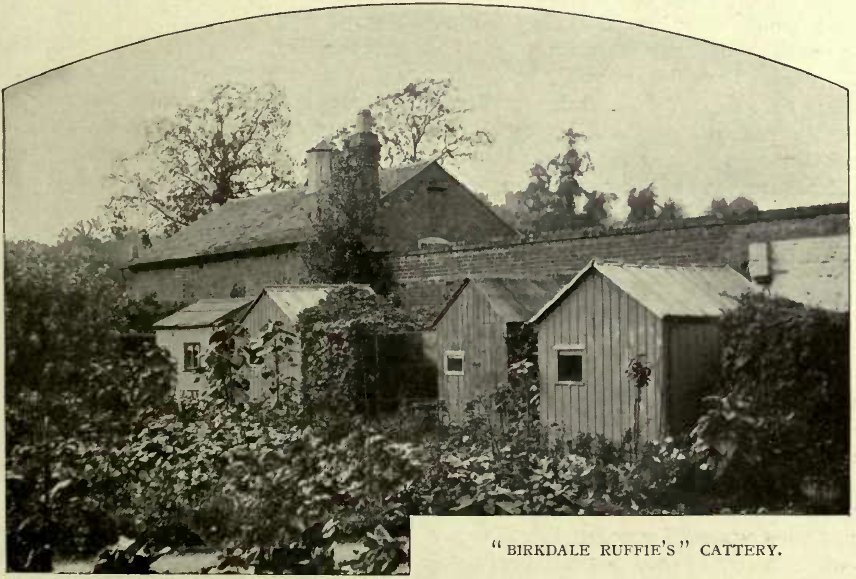
“ I once had a good many brown tabby Persians, and people did not fancy them, as they said, ‚They are so like ordinary cats‘ — a great mistake ; but by gentle persuasion I managed to get one or two adopted. One lady some time afterwards candidly confessed, ‚ I could not now be satisfied with any other kind, I should miss the stripes so much on the face.‘ That is just it ; in a tabby you have a little more than your neighbours, who go in for self-coloured cats, and, though for the time being they are not quite so fashionable, you can chuckle to yourself if you own one, and feel quietly superior to fashion and the common herd, and hold your tabby still closer to your heart, and purr softly to yourself with ’satisfaction at its possession ; for I think one may say that for good all-round, everyday, reliable qualities, the brown tabby stands pre-eminent.
“ His constitut’on being good, he is not peevish ; he stands cold and heat, change of climate and surroundings, better on an average than any. Brown tabbies should have the under-coat a good golden hue, the markings black, clear, and distinct, rather too many than too few. A good-shaped body, lots of bone, a bold head, red nose, golden eyes, well marked on the chest, and no light colour on the lips and chin. These cats may with advantage be a good size. With care, the under colour may be bred to a grand copper colour ; a grey hue in brown tabbies is most undesirable.“
As regards brown tabbies in America, “ King Humbert “ and his children have always held their own. “ Humbert “ was bred in England, and as he is now dead I may be allowed to say that when fit and in good condition a better-
Coloured and smarter show cat never stood in a pen or outside, and he loved to show himseli off. The best kitten bred from him was “ Jasper.“ He was very short in leg, and quite lost in coat, his feet being hardly visible.“
To the readers of that very excellent American publication The Cat Journal the handsome portrait of “ Crystal,“ the brown tabby, is very familiar. The editor, Mr. C. H. Jones, writes thus to me :—'“ I am sending you some pictures as promised. The large photo is ‚ Champion Crystal,‘ son of ‚ Humbert,‘ a beautiful cat as to type and disposition. A peculiar thing about ‚ Crystal’s ‚ kittens is that they do not show very long hair till they are several months old.“
And now a few remarks as regards the mating of brown tabbies. I have tried several experiments, but if I were wishing to breed fine specimens I should continue to mate brown tabbies with brown tabbies. Such mating frequently results in a black or two, and these are generally good ones. The orange cross is sometimes successful in introducing a brighter tone, but I confess I have not had very good results from these attempts. I have on several occasions mated blues to my brown tabby stud, and although blue tabbies have appeared in the litters, I have also obtained blues with very grand heads, plenty of bone, and massive build. My famous “ Beauty Boy,“ a well-known winner and sire of bygone days, was bred from “ Rajah “ (a brown) and „Mater“ (a blue). I have been told by silver breeders that a brown tabby cross with chinchillas has often proved advantageous. It might be imagined that the silvers would be tinged with brown or streaked, but I have been assured this is by no means usual, and that the litters consist of good brown tabbies and equally pure silvers.
A well-known breeder of silvers says:— “ Although it may be incorrect to cross silvers and browns, it is often most successful. My first torn was a brown tabby with a white chin, and being mated with a silver queen the kittens were good browns and exquisite silvers, and there were lots of winners amongst them.
Many of the silvers were very pure in colour, with lovely markings. My old ‚ Climax,‘ whose pedigree was pure silver (‚ Topso ‚ and ‚ Lady Pink‘), was the sire of the noted brown tabby ‚ Birkdale Ruffie.‘ ‚
Before closing my article, I would remark that the brown tabby and sable, though often classed together, must not be confounded. The brown tabby is supposed to be the common ancestor of all our cats, and hence the tendency to revert to that colour, as in the case of the blue Rock pigeon. This being the case, surely we should have brown tabby cats more nearly approaching perfection than any other colour. They appear in very unexpected places—in a litter of chinchillas or blacks, or among our oranges, and sometimes where no brown ancestor can be traced. In the brown tabby there seems to be little or no inclination to lose the markings, as in other tabbies ; rather the contrary, for they overdo themselves sometimes, and form into solid black patches, thus causing the dark saddle, which is a serious fault in this breed. Query : Would generations of in-breeding produce a self brown, as with oranges and chinchillas ? I rather doubt it, as I think the common ancestor would, so to speak, “ chip in“ and assert himself.
As regards the sables, I may remark that they are late in maturing and do not acquire their marvellous colouring till about the second year. Anyway, they rarely make a sensation on their first appearance. As I write I am thinking of “ Persimmon Laddie,“ who seems to have developed his glorious copper coat in the course of a year, and when seen at the Crystal Palace show of 1902 was a“s near perfection in the matter of colouring as could be desired. I hope that in time this breed of Persians may find more admirers, and that with patience and perseverance a really good strain of grand-coloured, dark-chinned, and above all splendidly marked brown tabby cats may be seen at our shows.
In America, as will be seen from the following extract from Field and Fancy, the brownies are making good headway :— 15*
BROWN TABBIES IN AMERICA.
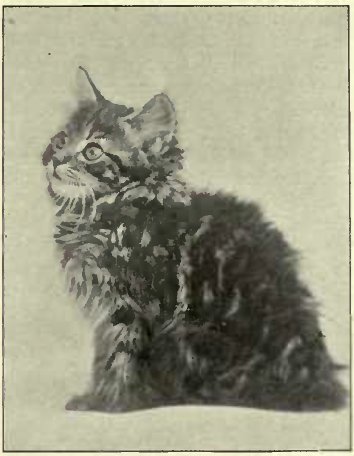
The brown tabby cat, whose fate seemed to hang in the balance for some time, is now, in America, on the road to social prominence, and daily we hear of the progress of the breed, so that the classes next winter seem to promise greater results than ever. From all over we hear of brown tabbies being bred and reared, and, what is more, finding homes at remunerative prices. In looking at the reasons for the popularity of the browns we do not have far to seek, for when once well tried, these cats wheedle their way into your affections by the strength and vitality they display, as a rule ; and the general average being level in their temper, with plenty of common sense, as well as bold, lovable cats, are very satisfactory to deal with. Besides these attributes, when bred properly, their colour is most fascinating, and has a faculty of growing upon one, and weaker colours seem tame by comparison.
So far as we can say, that as regards the brown tabbies, the whites and orange, there have been more concentrated efforts to breed good ones by design than in any of the colours, though the silver breeders are now coming up.
Taking a general look at our cats of this colour, we have little to be ashamed of, and the stock is good enough to make the nucleus of a fine lot of show cats, for they inherit their goodness from several generations of the colour, which is much to the point.
Our breeders will find that to breed good tabbies they will have to keep to blood lines, select the bestmarked ones, and not switch about in search of all sorts of blood crosses ; for the way to breed tabbies is to keep to the colour and get the marks, which too many crosses with solid-coloured cats are liable to spoil. After a time the purely bred and carefully bred strains will stand out and perpetuate themselves, and the chance-breds will go to the wall.
It has been surmised that the reason why the browns are so hardy is that possibly they more nearly approach the natural colour of cats in a wild state, and are perhaps not quite so artificial ; but the number that will be bred of superlative colouring to fill the standard from a show point of view will never be too numerous to command high prices, and the greater the competition the greater the value of the variety, as we see in our dogs. For it is in the popular breeds that the prices rule the highest, and the scarce ones seldom realise the same figures, because there is not the same keen competition to get the best.
When we look back we can call to mind quite a few good brown tabbies in the last seven years, and not very many bad ones, and for uniform quality our browns have been the equal of any colour.
Breeders should be careful to select those with the brown or red body colour, and with the stripes as distinct as possible. In our own experience with the colour we have found three varieties, and these are best described as they appear at birth. No. i is the cat with a narrow band down the centre of the back, and thin, narrow lines radiating therefrom. These marks may be very distinct when the cat is young, but are not strong enough for a long-haired cat, and the marks are lost when the coat grows. Though these cats are not the best of exhibition cats, they are very useful to breed to those too heavily marked. No. 2 is the cat that is heavily marked and carries too much black, and is often too grey in his body colour, but these, by being carefully bred to other colours, may throw the desired cat ; or No. 3, the cat with the orange body colour and the distinct black marks covering about a third of the surface of the cat. This latter we hope to see in greater numbers now that an organised effort is being made to breed the colour true.
A great many of our browns are clear of one great fault, which is the light chin and throat, and it is to be hoped that this will be continued.
Another fault that wants improving, and which is the prevailing fault in one of our prominent strains, is a rather sour green eye, and this has been the cause of some of them having to take a back seat on occasions. Last yeSar was fortunately a great educator for some of our best breeders, and they are now experimenting along the right lines, and are aware, when they lose, why it is so. As the years roll on those who do learn will not expect to win over better cats just because they think they ought.

